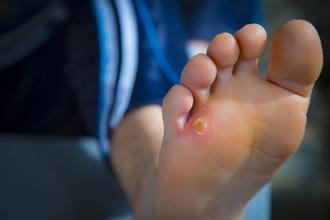Treating Your Corns

- posted: Dec. 13, 2021
From running miles to wearing shoes that are too loose or too tight, there are many reasons why you may develop a corn. A corn is your skin’s way of protecting itself when there is any friction or pressure placed on the area. While healthy individuals may be able to simply treat corns on their own with home care, those with diabetes or nerve damage should always turn to a podiatrist even for minor injuries such as corns or calluses.
What is a corn?
A corn is a buildup of skin that occurs when there is repeated friction or pressure placed on the skin. This buildup of skin helps to protect the skin underneath. Corns most commonly develop on the side or tops of the toes and can be either hard or soft. Soft corns often appear between the toes while hard corns typically form on the tops of the toes. While both corns and calluses are thickened areas of skin, calluses are often larger and typically develop on the bottoms of the feet.
Who is more at risk for developing corns?
Certain factors can make someone prone to corns and calluses. These include:
- Wearing shoes that are too tight or too narrow
- Having certain foot conditions that alter its structural alignments such as arthritis, bunions, or hammertoes
- Wearing shoes without socks
- Being a smoker
How do I treat a corn?
If you are a healthy individual, then simple lifestyle changes and home care can help to improve your corn. Soak the area for 5-10 minutes to soften the area. You may use a pumice stone to gently remove some of the thickened layers of skin. Make sure not to be too aggressive or to remove too much, as this can lead to bleeding and even infection. After pumicing the area, make sure to apply a moisturizer to your feet. If you have diabetes or nerve damage in your feet, do not try the pumice or remove the corn yourself. A podiatrist can provide you with the proper treatment.
Make sure you are wearing properly fitted shoes at all times. This can cut down on the number of corns or calluses you’ll deal with. Keep nails properly trimmed so they don’t rub against toes and cause corns. If certain areas of your feet are prone to corns, you may wish to apply protective adhesive padding to the area either to protect the corn or to prevent a new one from forming.
If you notice any changes to a corn, including signs of infection, it’s important that you turn to a podiatrist right away for care. While most corns will go away if you avoid any shoes that cause pressure or friction to the area, you should turn to a foot doctor if you have concerns.

- posted: Dec. 13, 2021
From running miles to wearing shoes that are too loose or too tight, there are many reasons why you may develop a corn. A corn is your skin’s way of protecting itself when there is any friction or pressure placed on the area. While healthy individuals may be able to simply treat corns on their own with home care, those with diabetes or nerve damage should always turn to a podiatrist even for minor injuries such as corns or calluses.
What is a corn?
A corn is a buildup of skin that occurs when there is repeated friction or pressure placed on the skin. This buildup of skin helps to protect the skin underneath. Corns most commonly develop on the side or tops of the toes and can be either hard or soft. Soft corns often appear between the toes while hard corns typically form on the tops of the toes. While both corns and calluses are thickened areas of skin, calluses are often larger and typically develop on the bottoms of the feet.
Who is more at risk for developing corns?
Certain factors can make someone prone to corns and calluses. These include:
- Wearing shoes that are too tight or too narrow
- Having certain foot conditions that alter its structural alignments such as arthritis, bunions, or hammertoes
- Wearing shoes without socks
- Being a smoker
How do I treat a corn?
If you are a healthy individual, then simple lifestyle changes and home care can help to improve your corn. Soak the area for 5-10 minutes to soften the area. You may use a pumice stone to gently remove some of the thickened layers of skin. Make sure not to be too aggressive or to remove too much, as this can lead to bleeding and even infection. After pumicing the area, make sure to apply a moisturizer to your feet. If you have diabetes or nerve damage in your feet, do not try the pumice or remove the corn yourself. A podiatrist can provide you with the proper treatment.
Make sure you are wearing properly fitted shoes at all times. This can cut down on the number of corns or calluses you’ll deal with. Keep nails properly trimmed so they don’t rub against toes and cause corns. If certain areas of your feet are prone to corns, you may wish to apply protective adhesive padding to the area either to protect the corn or to prevent a new one from forming.
If you notice any changes to a corn, including signs of infection, it’s important that you turn to a podiatrist right away for care. While most corns will go away if you avoid any shoes that cause pressure or friction to the area, you should turn to a foot doctor if you have concerns.
